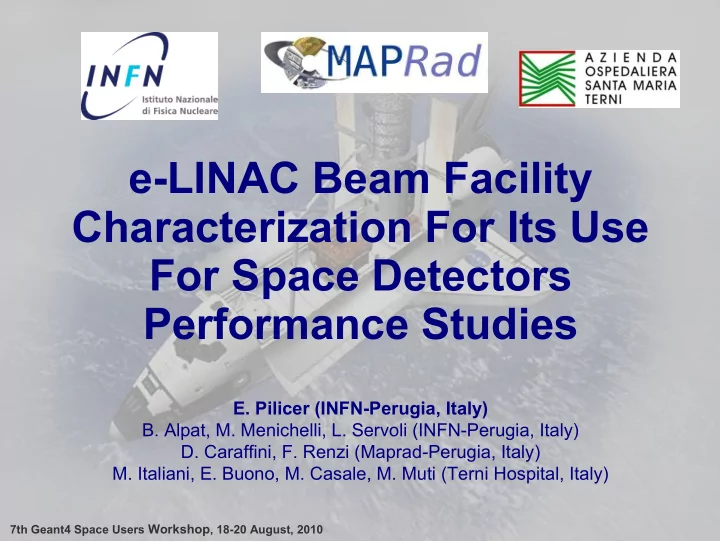

e-LINAC Beam Facility Characterization For Its Use For Space Detectors Performance Studies E. Pilicer (INFN-Perugia, Italy) B. Alpat, M. Menichelli, L. Servoli (INFN-Perugia, Italy) D. Caraffini, F. Renzi (Maprad-Perugia, Italy) M. Italiani, E. Buono, M. Casale, M. Muti (Terni Hospital, Italy) 7th Geant4 Space Users Workshop , 18-20 August, 2010
Outline Motivation Beam & Dose profiles Available energy & Flux @ detector surface Conclusions 1 7th Geant4 Space Users Workshop , 18-20 August, 2010
Motivation The goal is to use of AOT’s e-Linac for Space Detectors‘ Performance testing To do this we need full Monte Carlo (MC) description of irradiation system as well as a Beam Monitoring Detector system (BMDS) Advanced Markus Chamber MC (Geant4) Provided by Beam Profile Beam Profile Terni Hospital Dose Profile Energy Fluence Double Sided Silicon Detector Beam Profile Data (BMDS) Charge Provided by Flux Maprad Plastic Scintillator+SiPM Energy Flux 2 7th Geant4 Space Users Workshop , 18-20 August, 2010
Terni Hospital e-Linac Entrance window thickness 0.03 mm Advanced Markus Chamber Sensitive volume 20 mm 3 PTW-34045 Source to Surface Distance SSD (100 - 200 cm) Linac DUT e- head Applicator shield Simulated Accelerator Head 3 7th Geant4 Space Users Workshop , 18-20 August, 2010
Physics Lists & Applied Cuts Two kinds of physics list classes are available; G4VUserPhysicsList for relatively simple physics lists G4VModularPhysicsList for detailed physics lists Recommended Built-in Physics used G4EmStandardPhysics_option1 G4EmStandardPhysics_option2 G4EmStandardPhysics_option3 G4EmPenelopePhysics /process/eLoss/binsDEDX 480 /process/eLoss/binsLambda 480 G4EmLivermorePhysic Particle production thresholds (Cuts) = 0.1 and 1 mm StepSize (Steps) = 1 and 100 mm Generated primaries → mono-energetic electrons with no beam divergency (energy range 4-20 MeV) 4 7th Geant4 Space Users Workshop , 18-20 August, 2010
Beam Profiles Beam profile width from FWHM Sample plots @ 100 cm with option3 15 MeV (mono-choromatic, no beam divergence) 5 7th Geant4 Space Users Workshop , 18-20 August, 2010
Beam Profile Widths Primary: mono-energetic, 6 MeV, no beam divergence 6 7th Geant4 Space Users Workshop , 18-20 August, 2010
Beam Profile Widths Primary: mono-energetic, 15 MeV, no beam divergence 7 7th Geant4 Space Users Workshop , 18-20 August, 2010
Beam Profile Widths Beam Profile Width Percent Deviation = ((MC-Data)/Data)x100 @ 6 MeV e-Beam @ 15 MeV e-Beam Deviation starts after 130 cm G4EmPenelope better agreement for all Physics lists 8 7th Geant4 Space Users Workshop , 18-20 August, 2010
Dose & Energy Primary: mono-energetic, 6 MeV, no beam divergence 9 7th Geant4 Space Users Workshop , 18-20 August, 2010
Dose & Energy Primary: mono-energetic, 15 MeV, no beam divergence 10 7th Geant4 Space Users Workshop , 18-20 August, 2010
Available Energy @ Detector Surface Kinetic energy @ SSD=130cm For cuts=0.1mm and step=1mm For primaries; Fit Gauss & Sigma 11 7th Geant4 Space Users Workshop , 18-20 August, 2010
Available Energy @ Detector Surface Kinetic energy distributions for 15 MeV primary 12 7th Geant4 Space Users Workshop , 18-20 August, 2010
Available Energy @ Detector Surface Fluctuations in kinetic energy for 15 MeV primary 13 7th Geant4 Space Users Workshop , 18-20 August, 2010
Flux @ Detector Surface Steps to obtain flux Convert Energy [MeV] to Dose [Gy] Conversion factor [CF] = DoseGeant4 / DoseExperimental Flux = CF x DetectorSurfaceHits / DetectorSurface / Time [particles] / [cm 2 ] / [second] 6 MeV 15 MeV 14 7th Geant4 Space Users Workshop , 18-20 August, 2010
Flux @ Detector Surface From fits one can estimate @ a given distance; Flux Kinetic energy ~50x10 3 particle/cm 2 /sec σ in Kinetic energy @ 300cm cuts=0.1mm step=1mm 15 7th Geant4 Space Users Workshop , 18-20 August, 2010
Double Sided Silicon Detector (DSSD) Double sided silicon detector 35x35 mm 2 and 1.5 mm thick 64 channel on p and n sides with readout pitch of 500 µ m Sr-90 source Ar-20MeV/n 16 7th Geant4 Space Users Workshop , 18-20 August, 2010
Conclusions 1/2 Beam & Dose profiles from Advanced Markus Chamber used in AOT e-Linac is compared with full Geant4 simulations Measured Beam & Dose profiles are in better agreement with MC by using cuts=0.1 and step=1mm with G4EmPenelopePhysics To reach the same number of simulated events longer computation time is required for G4EmPenelopePhysics and G4EmLivermorePhysics In e-Linac facility we can obtain uniform energy distributions at almost all distances and deliver to DUT surface electron fluxes (from few particles/cm 2 /sec at about 550 cm up to 10 6 particles/cm 2 /sec at 100 cm) 17 7th Geant4 Space Users Workshop , 18-20 August, 2010
Conclusions 2/2 The distances larger than 200 cm requires to turn e-Linac head for horizontal irradiation (horizontally max available working distance is about 700 cm) In addition to instrumentation available at AOT we plan to develop The DSSD and Plastic Scintillator+SiPM detector developments for further comparison and validation studies e-Linac at Terni Hospital is a promising site for detector performance testing with electrons of energies ranging from 4-to-20 MeV 18 7th Geant4 Space Users Workshop , 18-20 August, 2010
Recommend
More recommend